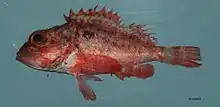Scorpaena brasiliensis
Scorpaena brasiliensis is a species of venomous fish of the family Scorpaenidae found in the Americas.
| Scorpaena brasiliensis | |
|---|---|
 | |
| Scientific classification | |
| Kingdom: | Animalia |
| Phylum: | Chordata |
| Class: | Actinopterygii |
| Order: | Scorpaeniformes |
| Family: | Scorpaenidae |
| Genus: | Scorpaena |
| Species: | S. brasiliensis |
| Binomial name | |
| Scorpaena brasiliensis Cuvier, 1829 | |
Common names
In English language they are known as barbfish, goosehead, scorpionfish, orange scorpionfish and red barbfish. In Brazilian Portuguese they are called beatinha, mamangá, niquim, stone niquim, scorpion fish and stone fish. In Spanish language, arracacho, escorpión pardo, rascacio, rascacio chasnete, rascacio chasnete ojo, rascacio pardo and frog chaznete rojo. In French language, rasca brésilienne.[1]
Description
They have a moderately short head and snout, the occipital pit is well developed, and a small to absent post-temporal spine. The pre-orbital bone has two spinous points on the maxilla, the suborbital crest has three spinous points, two of which are blunt. the propagule has five spines, a supplementary spine on the first, the second equal or sub-equal to the third, and the fourth and fifth spines with moderately small spines. In the dorsal, pelvic and anal fins it has elongated venom glands in the anterior portion of the spines. When threatened, the fish raises these spines that penetrate the meat and inject the toxin, the members of the Scorpaena genus, have about 12-13 spines, two in the pelvic fin and three in the anal fin.
Coloration
The coloring varies from red, orange or blue, with the lower part lighter. It has a dark spot on the upper flank behind the operculum, and several spots on the pale armpit of the pectoral fin, with two dark bands on the tail. Juveniles have brown spots with a light brown background, with the caudal peduncle paler than other parts of the body. 25 mm specimens have brown spots on the pectoral armpit.
Dentition
They have small teeth, located in the narrow bands of the mandible, palate and vomer.
Size
The largest specimen ever reported was about 35 cm long (13.8 inches), on average they grow 20 cm long (7.9 inches).[1]
Behavior
It has a slow behavior, it is usually camouflaged at the bottom of the coral reef (most often in protrusions and algae). It usually waits buried in the sand at the bottom or in debris, waiting for prey to attack immediately. When threatened, raise the dorsal fins with venom spines (to arch the body in a threatening position). Their prey includes shrimp, crabs and bony fish.[2] They are solitary-behavior fish, meeting other members of the species only during the mating season.[1]
Distribution and habitat
This species occurs in the Americas, in the Atlantic Ocean of Virginia, in the United States, north of the Gulf of Mexico, including the Greater and Lesser Antilles, to South of Brazil. This species has been reported in Bermudas, but has not been seen there since 1927. They mainly live on soft bottoms and coral reefs, from the coastline to depths of 100 meters, in bays, ports, continental shelves.[1]
Venom
These fish are venomous and can pose danger to humans, and they must be handled with care, the venom is located along the spines on the dorsal, pelvic and anal fin. contain neurotoxins, cytotoxins and potent hemotoxins, the envenomings result in intense and immediate pain, with swelling that radiate to the groin or armpit, and can last for several hours. Systemic symptoms are characterized by sweating, pallor, nausea, vomiting, diarrhea, heart problems, unconsciousness, shock and occasionally death.[2]
References
- "Scorpaena brasiliensis". Florida Museum. 2017-05-11. Retrieved 2020-10-19.
- https://www.acq.osd.mil/eie/afpmb/docs/lhd/venomous_animals_byspecies.pdf